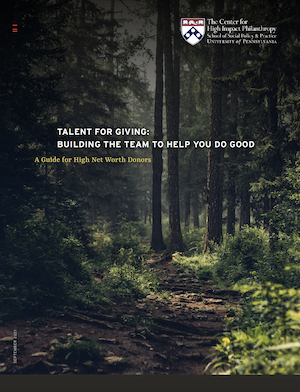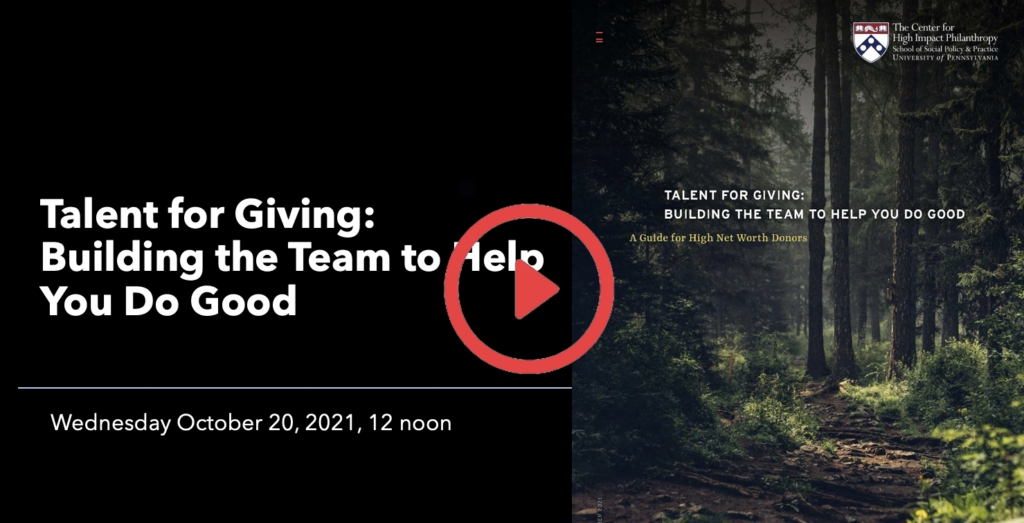Talent for Giving: Building the Team to Help You Do Good
A Guide for High Net Worth Donors
For high net worth donors, the potential to create positive social change is significant. The question is: how do you identify the right talent and build the team to realize that potential? This guidebook is our answer to that question.
Talent for Giving: Building the Team to Help You Do Good, A guide for high net worth donors, has strategies for finding the people, talent, and networks to help you do more good with your giving.
Watch the Talent for Giving Webinar
Watch this webinar recorded October 20, 2021, to learn how high net worth donors can identify people and networks to help create more impact with their giving.
What’s in the Talent for Giving Guide
Talent for Giving reflects over two years of applied research and the insights and resources of many people during a time of challenge and reckoning for philanthropy. During the course of this project, the world has been battling the COVID-19 pandemic’s unprecedented health, economic, and social effects. In the United States, we’ve borne witness to racial injustice exposed through police violence and COVID-19’s health and economic disparities. These injustices and disparities existed long before the current pandemic, but over the past year, we have seen new levels of collaboration, trust, and speed among donors who sought to help. Among some donors, we have also seen a new urgency to address the longstanding structural inequalities — particularly across race and gender — that prevent all people and all communities from thriving.
Our hope is that such collaboration, trust, and commitment to equity become a new normal, long past the end of this pandemic. Most importantly, we hope this work helps you find the people you’ll need so that we can all move faster toward greater social impact.
You’ll find guidance and case examples about:
- Common talent pitfalls and how to avoid them
- High-level sources of talent to draw from within the philanthropic ecosystem
- Determining your initial approach to achieving your social impact goals
- Talent to help you assess, learn, and improve
- More considerations, including what to look for in a critical first hire, salary benchmarks, and achieving diversity, equity, and inclusion
Table of Contents
Avoiding Philanthropy’s Talent Pitfalls
- We start with common misperceptions and myths that prevent donors from achieving the good they hope to create in the world. These pitfalls were reported in the literature, by nonprofit leaders, by longtime philanthropic advisors, by grantees, and by experienced donors themselves. Awareness of these pitfalls is the first step. You can avoid them by recognizing the capabilities required to do good and then sourcing talent from the broader talent ecosystem.
The Talent You Need for Greater Impact
The main body of this guide describes key inflection points along your giving journey when you need to find help and the sources and qualifications for the people who can help you move faster on the path to impact.
- Section 1: Talent to Help You Clarify Your Initial Goals and Approach
- Here we introduce the talent ecosystem from which you can source the help you need. We then discuss the early decisions you’ll need to make and what to look for in the people who can help you make those decisions well.
- Section 2: Talent to Implement Your Philanthropic Activities
- Once you have made early decisions regarding the cause areas you care about and the high-level approaches you want to fund, you will need help implementing. In this section, we define activities essential to strong implementation, including landscape scans, due diligence on people and organizations to fund, and grants management. We then describe the capabilities to look for in the people who will perform these activities, especially your first hire.
- Section 3: Talent to Help You Assess, Learn, and Improve
- Once you have funded activities designed to make progress toward social impact goals, you will need help understanding the results of those activities. You’ll need to compare actual activities to intended; measure results; capture lessons learned; and set goals for your next cycle.
The Need for Talent for Giving
Scholars estimate that there will likely be more wealth transferred to philanthropy during the first half of this century than in the entire 20th century. Over the past several years, there has been an increase in the number of billionaires and centimillionaires, accompanied by public commitments by many of the world’s wealthiest to use their money philanthropically. To effectively deploy this scale of philanthropic funds, high net worth donors will need help.
There are many professionals devoted to helping donors achieve the financial, legal, and tax goals associated with philanthropic activity. Such talent is relatively easy to identify and source among lawyers and tax experts specializing in estate planning, philanthropic service centers of private banks and wealth management firms, and specialists within family offices. However, we found relatively few resources focused on the talent that donors need to create social impact — i.e., the intended public good that inspires many to give and that matters to us all.
During interviews conducted for this project, we found the word “staff” was sometimes associated with factors that donors deemed undesirable (e.g., bureaucracy, expense, and loss of personal engagement) and not understood as necessary professional talent to achieve results. We also wanted to distinguish the people you need from the employees of a foundation, since foundations represent just one type of organization used for philanthropic activities and only 18% of total giving.
For all those reasons, we refer to the people who can help youachieve greater social impact as the “talent for giving.” We use the term “talent for giving” to refer to the ecosystem of people that includes philanthropic advisors and consultants, professional staff hired to guide and implement your activities, institutional grantmakers, subject-matter experts, peer donors, and friends and family. Most importantly, this talent includes the leaders and staff of the nonprofits and social enterprises that implement the work you will fund and the stakeholders of that work, including the beneficiaries themselves.
What’s Next
In early 2022 the Center for High Impact Philanthropy will launch workshops and an interactive tool to help you walk through talent decisions. For more in-depth exploration of talent and funding decisions, individual donors and foundation trustees are invited to High Impact Philanthropy Academy, CHIP’s flagship online funder education program. Our Spring session will run part-time March 6 – 17, 2023.


